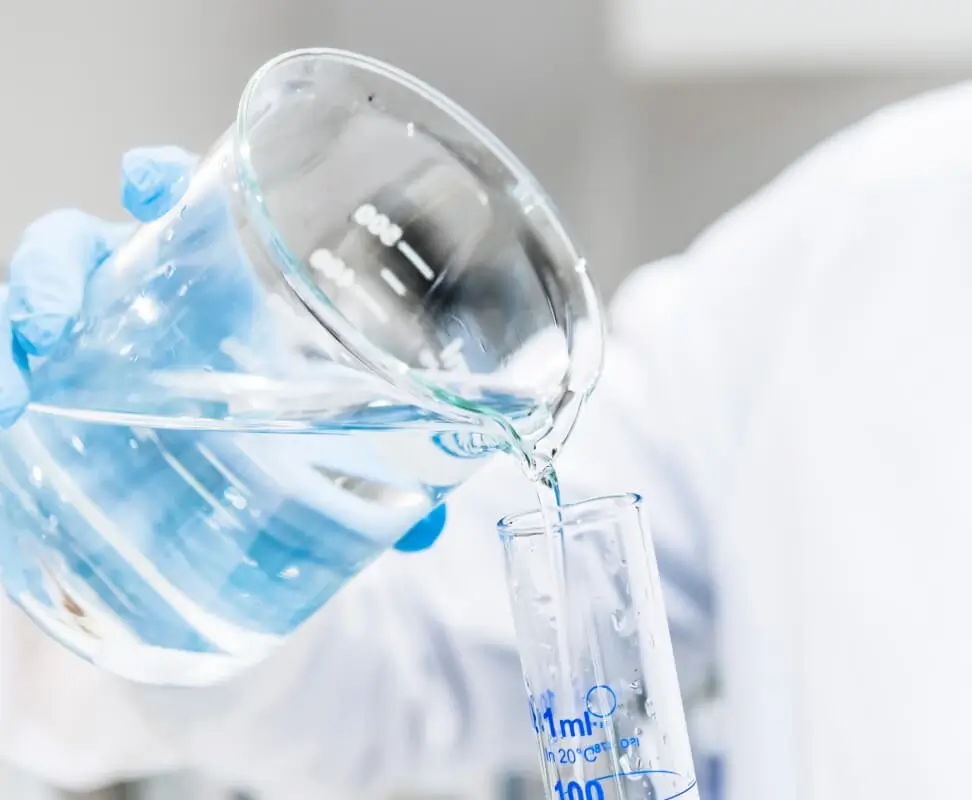
Water Testing
Water testing is paramount to ensure the product safety, efficacy, and quality of pharmaceutical and medical device products, as contamination, impurities, or lack of consistency can lead to serious patient health risks and compliance challenges. Infinity Laboratories’ network of state-of-the-art analytical laboratories offers comprehensive water testing services for the life sciences industry.
Water testing is paramount to ensure the product safety, efficacy, and quality of pharmaceutical and medical device products, as contamination, impurities, or lack of consistency can lead to serious patient health risks and compliance challenges. Infinity Laboratories’ network of state-of-the-art analytical laboratories offers comprehensive water testing services for the life sciences industry.
Water Testing
Water is widely used as a raw material, ingredient, and solvent when processing, formulating, and manufacturing pharmaceutical products, active pharmaceutical ingredients, intermediates, medical devices, and analytical reagents.

The water testing services offered by Infinity Laboratories address all grades of water, including:
- Purified water
- Water for irrigation
- Water for injection
- Water for inhalation
- Water for hemodialysis
- Bacteriostatic water for injection
Water Testing Services
Infinity Laboratories offers comprehensive water testing services to verify quality and purity based on standards set by the world’s leading standards organizations, including United States Pharmacopeia – National Formulary (USP-NF), European Pharmacopoeia (EP) and Japanese Pharmacopoeia (JP).
Nitrogen
Nitrogen
Standard: <USP29-NF24>
Nitrogen contains not less than 99.0 percent by volume of N2. Nitrogen (N2) is plentiful, inert, and commonly used for blanketing, purging, pressurizing, and mixing. It also protects precursors, reagents, and products from reacting with oxygen in the air. Additionally, nitrogen is used as a pressurizing agent to check for leaks in tanks, vessels, and other processing equipment or to transfer fluids.
Carbon Dioxide
Carbon Dioxide
Standard: <USP29-NF24>
Carbon dioxide contains not less than 99.0 percent by volume of CO2. Like nitrogen, carbon dioxide (CO2) is inert, making it highly useful for blanketing and packing, and is a widely used supercritical fluid. Carbon dioxide also plays an important role in micro and nanoparticle production.
Oxygen
Oxygen
Standard: <USP29-NF24>
Because it is one of the most effective oxidizing agents organic chemists have in their toolbox, oxygen (O2) has a key role in many processes.
- Oxygen contains not less than 99.0 percent by volume of O2 (oxygen produced by the air liquefaction process is exempt from the requirements of the tests for carbon dioxide and carbon monoxide).
- Oxygen 93 percent is oxygen produced from air by the molecular sieve process. It contains not less than 90.0 percent and not more than 96.0 percent by volume of O2, the remainder consisting mostly of argon and nitrogen.
Compressed Air
Compressed Air
Standard: ISO 8573-1
Testing based on required purity classes of compressed air with respect to both viable and non-viable particles, water, and oil & hydrocarbons.
Ammonia
Ammonia
Standard: USP <Monograph Bacteriostatic Water for Injection>
Bacteriostatic water for injection that is free of ammonia.
Calcium
Calcium
Standard: USP <Monograph Bacteriostatic Water for Injection >
Bacteriostatic water for injection that is free of calcium.
Carbon Dioxide
Carbon Dioxide
Standard: USP <Monograph Bacteriostatic Water for Injection>
Bacteriostatic water for injection that is free of carbon dioxide.
Carbonized Substances
Carbonized Substances
Standard: USP <Monograph Bacteriostatic Water for Injection>
Bacteriostatic water for injection that is free of carbonizable substances.
Chloride
Chloride
Standard: USP <Monograph Bacteriostatic Water for Injection>
Bacteriostatic water for injection that is free of chloride.
Coliforms
Coliforms
Standard: USP <1231>, < Standard Methods of Testing Water>
Microorganisms and certain microbes are prone to colonize pharmaceutical water systems. This test addresses microbiological examination of water samples to show that the water meets pharmaceutical requirements. All water must be free of coliforms.
Conductivity
Conductivity
Standard: USP <645>
Electrical conductivity in water measures the ion-facilitated electron flow through it. Water molecules dissociate into ions as a function of pH and temperature and result in a very predictable conductivity. Conductivity tests assess the conductivity of:
- Bulk water (e.g., PF, WFI, water for hemodialysis, and condensate of pure steam)
- Sterile water (e.g., sterile purified water [SPW], sterile water for injection [SWI], sterile water for inhalation and sterile water for irrigation)
Elemental Impurities
Elemental Impurities
Standard: USP <232> and USP <233>
Elemental impurities are defined as residual catalysts or environmental contaminants that may be present in drug substances, excipients, or drug products. Whether these impurities occur naturally, are added intentionally, or are introduced inadvertently, testing is required for assurance of the specified levels.
Heterotrophic Plate Counts
Heterotrophic Plate Counts
Standard: USP <1231> < Standard Methods of Testing Water>
Microorganisms and certain microbes are prone to colonize pharmaceutical water systems. This test addresses microbiological examination of water samples to show that the water meets pharmaceutical requirements.
Particulate Matter
Particulate Matter
Standard: USP <788>
Identifies particulate matter in injections and parenteral infusions, other than gas bubbles, unintentionally present in the solutions.
pH
pH
Standard: USP <791>
pH measurements are characterization assays to determine or confirm pH levels for drug compatibility, quality control, and/or shelf-life stability concerns. For compendial assays, pH is measured by a properly calibrated, potentiometric sensor and measuring system.
Residue on Evaporation
Residue on Evaporation
Standard: USP <Monograph Stronger Rose Water>
Stronger Rose Water is a saturated solution of the odoriferous principals of the flowers of Rosa centifolia L. (Fam. Rosaceae) prepared by distilling the fresh flowers with water and separating the excess volatile oil from the clear, water portion of the distillate.
Total Organic Carbon
Total Organic Carbon
Standard: USP <643>
Total organic carbon (TOC) is an indirect measure of organic molecules present in pharmaceutical waters that can be measured as carbon. Organic molecules can be introduced to the water from purification and distribution system materials, biofilm growing in the system, and packaging sterile and nonsterile waters.

